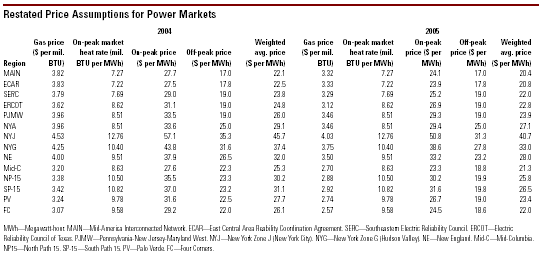Commodity Report: U.S. Power
Prices Record High in 2003
For the year 2003, record-high wholesale power prices were the defining feature
of the U.S. merchant power markets. Generation capacity based in coal, uranium,
and hydro benefited greatly from the high power prices, while generation based
in oil and gas benefited much less because their fuel costs also rose sharply.
Coal prices rose significantly in 2003, but the effect on coal generators was
probably minimal because most (85% or more) coal generators have locked up their
coal supplies under long-term fixed-price contracts.
Power prices across the U.S. continent generally rose on the order of 50% or
more in 2003. The increase is mainly attributable to an increase in gas prices.
Eastern regions generally experienced record high or near-record high prices.
Prices in the western regions were also the highest on record outside of the
2000-2001 California energy crisis. The Midwest had the biggest jump (82%),
while Florida had the smallest increase (17%).
Record High Prices Were Not Limited to On-Peak Power
Off-peak prices also rose about 50% across the U.S. and set record highs along
the way in most regions. This pattern runs contrary to the general assumption
that off-peak prices and gas prices are only weakly correlated. The Midwest had
a whopping 113% jump in off-peak prices, while Texas recorded an 86% jump.
Western regions were consistently 60% to 70% higher compared with 2002. Florida
was the only exception, where the average off-peak price actually fell 2%.
Market Heat Rates Still in the Dumps
However, the high power prices by no means imply that there is a shortage of
generation capacity. In fact, all evidence points to just the opposite. The
oversupply of generation capacity in most regions continues to persist and the
situation may have worsened over the course of 2003. Market heat rates, a key
indicator of supply/demand balance of generation capacity, have consistently
dropped in all regions, setting a new low for on-peak market heat rate across
the country (see “Market Heat Rate—A Useful Metric For the U.S. Electric
Industry”, Utilities & Perspectives, Sept. 11, 2003). A mild summer could
explain some of the decline in market heat rates but, since nonsummer month heat
rates also declined in 2003, the trend is therefore probably not solely
weather-related.

According to the forward market, the decline in market heat rates around the
U.S. is expected to continue, but slowing down significantly and certain regions
may even see some improvements. Compared with the forward market for 2003, 2004
market heat rates are expected to worsen somewhat for most of the U.S., except
for the South and California, which are expected to improve.
Adjustments to Power Price Assumption
Standard & Poor’s has increased its power price assumption for 2004 to
incorporate an upward revision of its gas price assumption of last week (see
Standard & Poor’s Utilities & Perspectives Jan. 12, 2004). The new
natural gas price assumption for 2004 is now $3.75 per million BTU (mmbtu) for
2004, an increase of 50 cents per mmbtu from the existing assumption of $3.25
per mmbtu. Standard & Poor’s gas price assumption and power price
assumption for 2005 and beyond will remain the same, except for some minor
adjustments to regional basis differentials. (See table for the restated price
assumptions for each U.S. region).
Coal Prices
Coal prices experienced a dramatic rise in early 2001, and are currently
experiencing another impressive increase. In both cases, the rise in coal prices
followed a rise in natural gas prices, but with a several-month lag. At the
height of last price spike in the middle of 2001, eastern coal reached $48 per
ton and western coal was about $11 per ton. For most of 2002, coal prices stayed
mostly below $30 per ton, but increased again in 2003. The rise in coal prices
accelerated toward the end of 2003 and is currently trading around $37.50 per
ton for eastern coal and $7.00 per ton for western coal. The more dramatic rise
in eastern coal prices may be attributable to the declining production and
increasing production cost of eastern coal.
Current market prices are above Standard & Poor’s expectation of long-run
averages for coal prices, which are $30 per ton for eastern coal and $5.50 per
ton for western coal. n
Tobias Hsieh
New York (1) 212-438-2023.
Previous articles are available in the S&P
Archive.
This report was reproduced from Standard &
Poor's RatingsDirect, the premier source of real-time, web-based credit
ratings and research from an organization that has been a leader in
objective credit analysis for more than 140 years. To preview this
dynamic online product, visit our RatingsDirect website at http://www.standardandpoors.com/ratingsdirect
Standard & Poor's.
Setting The Standard. |
| Contact Standard & Poor's Analysts: |
Telephone |
| Paul Lund, London |
+44 20-7826-3715 |
| Daniela Katsiamakis, London |
+44 20-7826-3519 |
| Peter Kernan, London |
+44 20-7826-3618 |
| Anthony Flintoff, London |
+44 20-7826-3874 |
